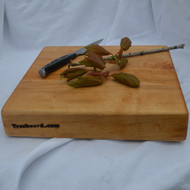What Is Hard Maple?
28th Apr 2020
Hard maple is sugar maple. It’s the big, slow-growing, cold-weather-loving maple of the Appalachians, the northeastern U.S. and Canada. When you’re training the sap for syrup, it’s sugar maple; when you’re cutting it up for furniture or flooring, it’s hard maple. The scientific name, Acer saccharum, means “sugar maple,” but most tourists value the trees for their splendid fall foliage. Meanwhile, carpenters love the wood for its strength and hardness. Sometimes, especially in Canada, it’s called “rock maple,” and some companies, apparently for marketing purposes, refer to it redundantly as “hard rock maple.” (To me that sounds like a heavy-metal band in Ottawa.)
Whatever you call it, Acer saccharum is the Cadillac of North American hardwoods. The first think you notice is the golden color, hinting at American optimism in a world of dark mahogany and smoky walnut veneer.
The second thing you notice is the heft. Hard maple is fully one-third heavier than some of its softer cousins, including the silver maple that grows outside our workshop. How do we know we purchased hard maple? We cut a perfectly square block, measured the volume, weighed it and calculated the density. Nearly 43 pounds per cubic foot for a very dry sample that we turned into a medium cutting board.
When you cut the wood with power tools, the blade moves smoothly, like sharp scissors through canvas. But unless you move quickly, the blade burns the wood a bit, filling the shop with a pleasant campfire smell. (At Treeboard we sand any burns off, of course.)
Rubbing in raw linseed oil only brings out the golden color. The grain tends to be very regular, and it’s downright boring compared with walnut burl or gnarly oak. Yet as with Douglas fir the neat grain seems to be related to the wood’s strength. Areas near knots are dramatically wavy, and of course hard maple can on occasions produce the stunning “bird’s-eye” or “tiger” patterns.
Thankfully, sugar maple isn’t threatened, and the wood has been sustainably logged for centuries. It’s the state tree in four states, including nearby West Virginia.
—Will
Spencerville, Md.
Click here to see our brand-new hard maple cutting boards.

